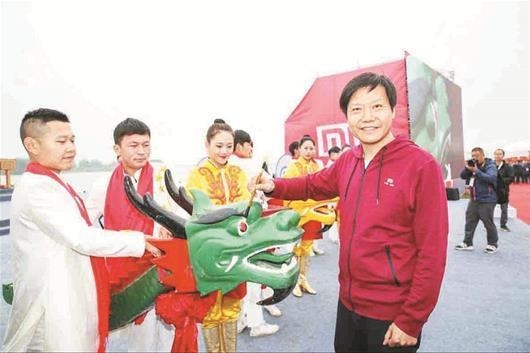
Yesterday, the Xiaomi Global Supplier Conference concluded in Xiantao. Lei Jun, founder and chairman of Xiaomi Technology, took to the stage and joined the team in a lively performance, showcasing the traditional culture of Hubei’s Dragon Boat Race to an international audience.
During an interview with reporters from Chutian Metropolis Daily, Lei Jun emphasized that Hubei and Wuhan hold significant advantages in terms of location and talent pool, and are well-positioned to benefit from the industrial shift toward smart manufacturing. In the coming years, Xiaomi plans to invest 2.3 billion yuan in Wuhan to establish a comprehensive Xiaomi headquarters, aiming to support the development of his hometown.
The Hometown Drumbeat
Hubei Seizes Industrial Transfer Opportunities
Last morning, a dragon boat race was held at the Wuletai Scenic Area on Pai Lake in Xiantao, as part of the global supplier conference. In the afternoon, Lei Jun shared his thoughts on the event: “Not only foreign suppliers, but even friends from Guangdong were amazed by our dragon boat race.â€
This might be one of the key reasons why Lei Jun chose to host the global supplier conference in his hometown, Xiantao.
Lei Jun openly stated that both public and private sectors hope to contribute to the development of Xiantao and Hubei through investment, encouraging companies worldwide to consider their hometowns when planning domestic operations.
“Now, first-tier cities have reached a new stage of development and are facing the need to transfer industries to central and western regions while upgrading their own sectors,†said Lei Jun. He added that Hubei has clear geographical advantages in absorbing various forms of industrial transfers, especially in smart manufacturing.
Beyond its role as a transportation hub, Wuhan also excels in education, human resources, and technological innovation. The city offers a good living environment and relatively affordable housing, making it attractive for companies across the country to invest. These factors position Hubei well to seize opportunities from industrial transfers.
Helping Jiangcheng
Xiaomi to Invest 2.3 Billion Yuan in Wuhan
Lei Jun revealed that in the next few years, Xiaomi will invest 2.3 billion yuan in Wuhan, accelerating the construction of its new headquarters in the city.
In terms of business expansion, Xiaomi is speeding up its strategy to build its own retail stores under the "self-built" model. Currently, Xiaomi is managing its stores directly. According to Lei Jun’s vision, the company aims to open shops and manage Xiaomi homes in every county, city, and township. For example, in Henan Province, which is being piloted, the area is divided into 158 grids, with at least one Xiaomi home located at each grid node and small Xiaomi stores covering each township. This high-quality sales network ensures that consumers can access affordable products easily.
Lei Jun concluded by saying that no matter where they are from, people around the world appreciate beautifully designed, high-quality, and reasonably priced products. Xiaomi’s current success reflects China’s strong manufacturing capabilities. Chinese products are gaining influence and improving their image globally through high quality and cost-effectiveness. “In the next three to five years, Xiaomi aims to enter the top 5, then the top 3, and eventually become the leader in mobile phone sales in more countries,†he said.
Calling It “Milletâ€
Innovation Drives Competitiveness
This year, Xiaomi’s full-screen technology, seen in the Xiaomi MIX2, has inspired many other brands. Lei Jun remarked, “This shows that Xiaomi’s innovation has been recognized by the industry and is leading the future design direction of mobile phones.â€
He also admitted that in the past two years, Xiaomi faced major challenges but managed to turn things around quickly. At the core of this success was a focus on consumer demand and the continued validation of Xiaomi’s values and business model. “Super strong technological innovation has led to a series of high-quality products, enhancing Xiaomi’s competitiveness,†he said.
In addition, the popularity of the “Millet House†as a physical retail channel highlights Xiaomi’s success in the retail sector. “The Millet House in Wuhan Optical Valley was packed with visitors for eight consecutive days during the National Day holiday,†Lei Jun noted.
It includes Light sources, terminals, sensors, converters, adapters, light boxes, inductive ballasts, electronic ballasts, acrylic accessories, plastic accessories, special lamps, filaments, electronic components, capacitors, brackets, hardware, ceramic parts, Plastic parts, glass parts, die-casting parts, rectifiers, starters, transformers, voltage stabilizers, wires, sockets, plugs, switches, lamp holders, lamp holders, lamp panels, optical fibers, crystal parts, lamp tubes, lamp posts, lamp shades, Base, center pillar, bulb, ballast, bottom plate. According to different protection requirements, there are many small accessories. Such as rubber plugs, eight-shaped buckles, terminals, crimping buckles, pipe plugs, dental pipe screws, gaskets and so on.:Hard wire straight plug, soft and hard wire universal, push type, track type, waterproof series, etc.
Our factory includes PCT41 series Cage Spring Terminal Blocks,CH Series Press Type Terminal Block etc.
PCT41 series Cage Spring Terminal Blocks,CH Series Press Type Terminal Block etc
Ningbo Bond Industrial Electric Co., Ltd. , https://www.bondelectro.com